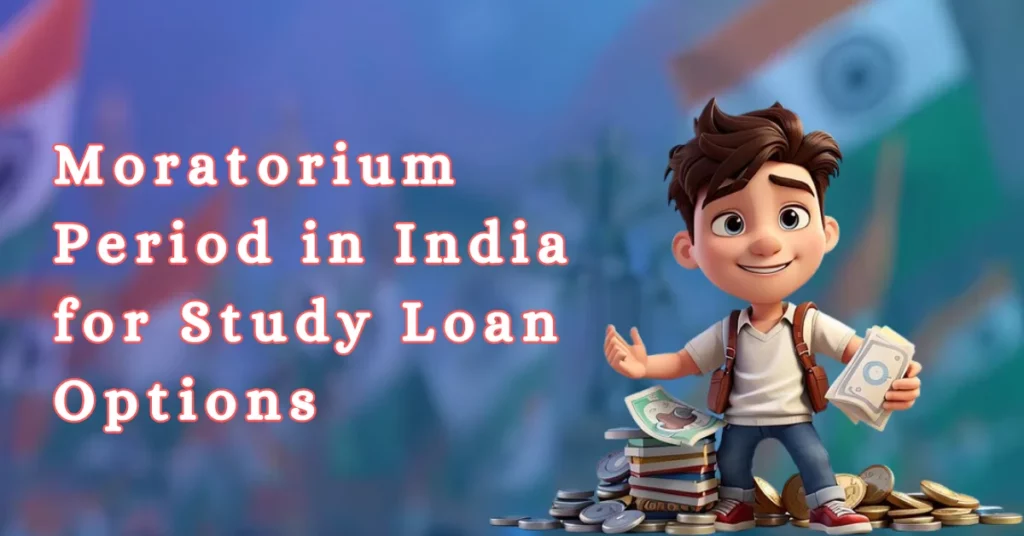
Table of Contents
- What is the Moratorium Period for India Education Loans?
- Moratorium period in India: Key features
- Benefits of the Moratorium period
- Moratorium Periods Offered by Various Lenders
- Different options to repay the education loan in India
- Example of Moratorium Period
- Conclusion
- Frequently Asked Questions
A moratorium period in India is a designated timeframe during which a borrower is not required to make repayments towards the principal amount of a loan, although interest continues to accrue.
This temporary relief is typically offered to individuals facing financial difficulties, undergoing a career transition, or pursuing higher education. Financial institutions follow moratorium guidelines set by a country’s central bank. Importantly, this grace period does not adversely affect the borrower’s credit score and provides crucial assistance to individuals navigating challenging circumstances.
Let’s explore this further.
What is the Moratorium Period for India Education Loans?
The moratorium duration in study abroad loans is a specific period during which borrowers aren’t required to make any payments. Essentially, it is a temporary pause in loan repayment obligations. During this period, banks do not enforce repayments from the students.
The Reserve Bank of India has mandated all government banks to provide a moratorium period on education loans.
Moratorium period in India: Key features
- The Reserve Bank of India (RBI) mandated education loans for students from all socioeconomic backgrounds.
- A modal educational loan scheme was designed by the RBI, taking into account the financial challenges faced by eligible students pursuing studies abroad.
- Public banks and some commercial institutions provide a payment-free moratorium period to students.
- Certain RBI-approved lenders offer a moratorium period, allowing students a convenient timeframe to start repayment.
- Commercial lenders such as private banks and NBFCs offer a grace period for repaying student loans, similar to government banks, but it’s not entirely debt-free.
- During the moratorium period, partial interest payments are allowed by private banks and NBFCs.
- This partial payment system means students can pay a portion of the interest accrued during the moratorium period, depending on the lender’s regulations.
- Depending on the student’s profile and lender regulations, private banks and financial institutions may demand full payment of the interest rate during the moratorium period.
- The provision for repayment of student loans during the moratorium period is subject to regulations set by the RBI.
Benefits of the Moratorium period
- Financial Breathing Space: The moratorium period offers a grace period post-education for managing job-related expenses without loan repayments.
- CIBIL Score Unaffected: Borrowers’ CIBIL score remains unchanged in the course of the moratorium length, although they do not make any repayments, making sure they don’t default on their loans.
- Career Transition: It acknowledges the shift from student to professional, allowing focus on career building without immediate loan repayment pressure.
- Skill Enhancement: Borrowers can use the period for further education or skill development, enhancing job prospects.
- Job Search: Graduates can focus on finding suitable jobs rather than settling for immediate options due to financial constraints.
- Financial Planning: It provides time for assessing finances, budgeting, and planning loan repayments for informed decision-making.
- Reduced Immediate Stress: Alleviates stress during the initial post-education phase, allowing adaptation to new routines.
- Preparation for Loan Repayments: Borrowers can use the period to understand loan terms, calculate repayments, and explore repayment options.
Moratorium Periods Offered by Various Lenders
In India, financial institutions for studying overseas loans are classified into differing types, such as public and private banks and NBFCs. Each lender has its very own compensation guidelines, including the length of the moratorium length. Here’s a breakdown of the moratorium periods given via these lenders:
- NBFCs: Lenders like NBFCs commonly offer a moratorium starting from 6 months to a year. However, for this duration, borrowers may still be required to pay simple interest while the repayment of the principal loan amount is deferred. Depending on the borrower’s capacity to pay, NBFCs may additionally require partial interest payments, with the remaining loan amount added to the principal loan balance. Repayment of the primary loan begins after the moratorium duration ends.
- Public Banks: Government banks usually provide a moratorium lasting up to six months or 1 year, depending on the bank’s education loan rules and policy. During this period, college students aren’t obligated to make any payments.
- Private Banks: Moratorium periods offered by private sector banks also typically extend up to 12 months. Similar to NBFCs, borrowers may need to pay simple interest during this period, while repayment of the principal loan amount begins after the moratorium period concludes.
Different options to repay the education loan in India
| Repayment Option | Description |
| Simple Interest | The borrower continues paying Simple Interest during the study period. Simple Interest does not accumulate on the Principal amount. EMI comprises Principal + Compound Interest. |
| Partial Simple Interest | The borrower pays only a portion of the simple interest while the remaining interest accumulates on the principal amount. Compound interest is charged on the principal + remaining simple interest. |
| EMI | Borrower does not make any payments until the end of the moratorium period. Payments are made in EMIs thereafter, with Compound Interest charged on the Principal + Simple Interest. |
Example of Moratorium Period
Let’s illustrate the concept of a moratorium period with an example. Suppose you take out an education loan of ₹100,000 from XYZ Bank in January 2024 to pursue further studies. The loan agreement specifies repayment in 12 installments. If XYZ Bank offers a 12-month moratorium period, your monthly installments will commence in January 2025. This means you won’t have to make any EMIs until December 2024.
Conclusion
A moratorium period provides relief from loan repayment pressure for students during their studies. It’s important to note that this period does not accrue interest. Therefore, starting loan repayment early can reduce the interest charged on the remaining balance of an education loan.
If you need information or guidance on financial matters, our team of loan experts at Nomad Credit is always available to assist you.
Frequently Asked Questions
Am I eligible to opt for a moratorium period, or is it mandatory?
For many education loans, a suspension of payments is granted automatically after school. However, some lenders give the borrowers the chance to choose whether to have that period as a moratorium or to start the payment deadlines at the very beginning. Read the loan agreement conditions and recommendations before you take the loan.
Are there any negative sides to accepting the moratorium?
The moratorium period offers you a break from current repayment schedules, but it’s important to think about accrued interest. Selecting the moratorium period will trigger a slight increase in the cumulative loan repayment amount as the interest accumulates in during this time.
What is the maximum duration of the moratorium?
Different moratorium lengths exist based on each lending institution’s loan terms and lending policies. Typically, deferment periods vary from a few months to several years, depending on the type of credit received.
Can I prolong my loan moratorium period in case of an education loan? How?
Sure, you can prolong the 6-month moratorium to 12 months for government banks but not private banks and NBFCs. To achieve this, you should simply write a letter to the bank asking for an extension of the current moratorium term.

